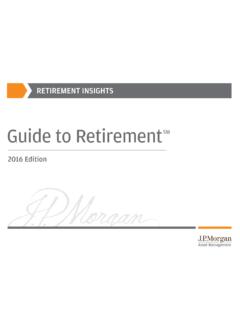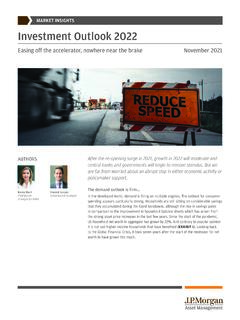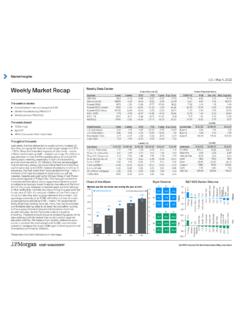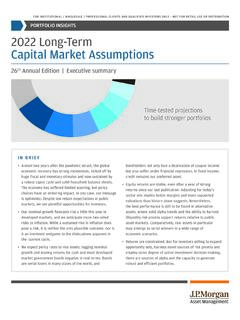Transcription of Infrastructure Investing - am.jpmorgan.com
1 FOR INSTITUTIONAL/WHOLESALE/PROFESSIONAL CLIENTS AND QUALIFIED INVESTORS ONLY NOT FOR RETAIL USE OR DISTRIBUTION. Infrastructure Investing Key benefits and risks | 4Q2015. Infrastructure is an expansive asset class, covering a wide span in Infrastructure CAN BE DEFINED the risk-return spectrum. The risk, return, and cash flow expecta- tions vary on multiple dimensions such as an asset's maturity, ser- AS THE ESSENTIAL FACILITIES AND. vice area demographics, regulatory and political risks. Core infra- SERVICES UPON WHICH THE. structure covers the lower risk-lower return end of the spectrum. ECONOMIC PRODUCTIVITY OF. A core Infrastructure asset is defined as an Infrastructure asset for SOCIETY DEPENDS. which the cash flows to equity owners is forecastable with a low These assets are typically involved in the movement and storage margin of error. In that regard, core Infrastructure consists of of goods, people, water, and energy, and include: assets that are (i) mature beyond their demand ramp-up phases, Regulated assets, including electricity transmission lines, gas (ii) functioning in established and transparent regulatory and politi- and oil pipelines, water distribution systems, and wastewater cal environments, (iii) serving demographically and economically collection and processing systems sound service areas, and (iv) long-lived with minimal obsolescence Transportation assets, including toll roads, bridges, tunnels, or technology risks.
2 Regulated utilities, energy assets with long railroads, rapid transit links, seaports, and airports term contracts, and transportation assets with long term conces- Communications assets, including radio and television broad- sion agreements in the OECD economies can be defined as core cast towers, wireless communications towers, cable systems, assets, as long as they they have the characteristics stated above. and satellite networks Historically, core Infrastructure assets (the lower end of the risk Social Infrastructure assets, including schools, hospitals, spectrum) have offered equity investors low double digit returns courthouses, and other government buildings. with the majority of that return coming from cash yield and the rest from capital appreciation. Infrastructure Investing . EXHIBIT 1: ILLUSTRATIVE RETURNS FOR CORE Infrastructure ASSETS. Relative risk Avg. expected Capital appreciation Sector assessment Avg. cash yield % return (%)1 potential Social Infrastructure /PPPs and PFIs2 Low 4 5 5 8 Low Contracted power generation3 Low 5 8 6 10 Low Regulated utilities Low-medium 4 7 8 10 Low-medium Toll roads Low-medium 4 6 8 12 Low-medium Airports Medium 5 7 10 15 Medium Seaports Medium 5 7 11 16 Medium Freight rail Medium-high 6 8 12 16 Medium-high Telecommunication Infrastructure High 5 9 12 18 High Merchant power generation High 0-4 14 20 High Source: Morgan Asset Management as of March 31, 2015.
3 1. Assumes sector average loan-to-value ratios, ranging between 50% and 85%. 2. PPP stands for Public Private Partnership and PFI stands for Private Finance Initiative; both terms describe assets with government guaranteed payment mechanisms. 3. Assumes contract length of 10 or more years. The following illustrative returns and yields (Exhibit 1) are other vital functions within their communities. These trends based on historical data and our expectations. Given the present a significant opportunity for investors to acquire and changing market environment, and increasing allocations to manage high-quality assets around the world. Infrastructure by institutional investors, the return expectations Investors are increasingly considering Infrastructure as an are also subject to change. attractive investment alternative primarily because these There is a current and growing global need for governmental assets can provide portfolio diversification with the potential bodies to finance, maintain, modernize, expand and develop for stable cash In the current market environment, the Infrastructure facilities essential to ensuring continued growth demand for core plus private Infrastructure has been particu- in economic activity and productivity.
4 It is estimated that $45 larly strong because these investments seek to offer long-term trillion will be required to modernize and expand water, electric- exposure to relatively stable, economically insensitive, inflation ity and transportation systems in the , Canada and Western protected cash flows. These assets have the potential to gener- Europe over the next 15 With governments increasingly ate low volatility, consistent growth of cash flows and returns hard-pressed to obtain the capital required to maintain and that are uncorrelated with other asset classes, resulting in very expand their Infrastructure , they have begun to recognize that attractive diversification benefits for investors. This paper sum- private sector capital can be used to satisfy those Infrastructure marizes the key benefits and risks of Investing in Infrastructure . needs, allowing them to focus existing limited resources toward Lower Higher Relative Risk / Return Economic sensitivity Regulated GDP Sensitive Sub-sector Demand drivers utilities transportation Demand risk Stage of Construction risks Existing New build development Usage history (Brownfield) (Greenfield).
5 Regulatory Developed Emerging Geography Political markets markets Legal Debt vs. Equity Senior Minority equity Capital structure % of equity ownership secured debt ownership Governance/management 5. OECD Publishing, Strategic Transport Infrastructure Needs to 2030, September 2012 and IEA, Energy Technology Perspectives, August 2013. 6. Infrastructure Investing : A Portfolio Diversifier with Stable Cash Yields, Morgan Asset Management 2014. 2 KEY B EN EF IT ES A N D RIS K S. Infrastructure Investing . Infrastructure assets have several unique characteristics Sub-sector: Each Infrastructure sub-sector has different risk that make them attractive investments. Here are some factors, return drivers, and economic sensitivities. Due to low potential benefits: correlation among sub-sectors, these risks can be reduced by constructing a well diversified Infrastructure portfolio. Stable cash flows and resilience to economic fluctuations: Because most Infrastructure assets have monopolistic posi- Political and regulatory: Different countries/regions have tions in and provide essential services to the markets they different political, regulatory and legal frameworks.
6 Serve, demand is often very stable. For those assets, usage Especially in jurisdictions with relatively shorter regulatory does not materially decline with price increases or during histories, regulatory decisions may be inconsistent, increas- periods of economic weakness. ing uncertainty for investors. Investing in politically stable regions with established legal and regulatory frameworks Diversification benefits: As a result of low usage volatility, can reduce these risks. economic insensitivity, and inflation-protection characteris- tics, a portfolio of Infrastructure assets has low correlation to Stage of development: Development projects face higher other major asset classes resulting in attractive diversifica- construction risks and demand uncertainty compared to tion benefits. mature assets. Investors can choose to avoid these risks by Investing only in existing Infrastructure or by signing appro- Attractive long-term returns: The services provided by infra- priate contracts with the developers.
7 Those willing to take structure assets are essential for the functioning of a society. these added risks may be compensated with higher returns. While not allowing Infrastructure assets to charge monopoly prices, governments must allow private owners to earn fair Liquidity: Due to the size of some assets, the limited number returns in order to incentivize them to keep facilities in good of potential buyers and regulatory approval requirements, working order, and invest for future growth and modernization. divestments of Infrastructure assets can take a significant amount of time and effort. An open-ended fund provides a Inflation protection: Rates charged by Infrastructure assets long-term investment approach that will not force asset sales are determined by regulators, concession agreements with and may provide added liquidity relative to closed end funds. governments, and long-term contracts. Owners generally have the ability to increase rates at some level linked to Credit market risk: Infrastructure assets providing stable inflation and/or the economy over time.
8 Cash flows present opportunities to boost return on equity via leverage at the operating company level. Credit market Concurrently, while they can be mitigated, there are several conditions impact the amount, cost and terms of credit key risks of Infrastructure Investing : available to Infrastructure assets. Managers can mitigate this risk by making conservative refinancing assumptions when EXHIBIT 2: ELECTRICITY DELIVERED TO RESIDENTIAL AND COMMERCIAL CONSUMERS (ROLLING 12 MONTHS) VERSUS THE AVERAGE ANNUAL RETAIL. PRICE (IN 2014 PRICES) IN THE , JANUARY 1974 DECEMBER 2014. Recession Residential consumption Commercial consumption Average retail price (right axis). 140 18. 120 16. 14. 100. Cents per kWh 12. Billion kWh 80 10. 60 8. 6. 40. 4. 20 2. 0 0. 1974. 1975. 1977. 1978. 1980. 1981. 1983. 1985. 1986. 1988. 1989. 1991. 1993. 1994. 1996. 1997. 1999. 2000. 2002. 2004. 2005. 2007. 2008. 2010. 2012. 2013. Sources: EIA and Morgan Asset Management, as of January 2015. MORGAN ASSE T MA N A G E ME N T 3.
9 Infrastructure Investing . EXHIBIT 3: NATURAL GAS CONSUMPTION IN RESIDENTIAL AND COMMERCIAL SECTORS AND NATIONAL HEATING DEGREE DAYS (ROLLING 12 MONTHS). VERSUS THE REAL NATURAL GAS PRICE IN THE , JANUARY 1974 DECEMBER 2014. Recession Residential consumption Commercial consumption Heating Degree Days Citygate price (right axis). 6 16. 14. USD per thousand cubic feet Trillion cubic feet of gas and 5. thousand degree days 12. 4. 10. 3 8. 6. 2. 4. 1. 2. 0 0. 1974. 1975. 1977. 1979. 1981. 1982. 1984. 1986. 1988. 1989. 1991. 1993. 1995. 1996. 1998. 2000. 2002. 2003. 2005. 2007. 2009. 2010. 2012. 2014. Sources: EIA and Morgan Asset Management, as of January 2015. underwriting and employing leverage prudently, in quantity, Exhibit 3, the demand for natural gas is driven by temperature;. structure and tenor. it is not dependent on the economy or on the price of the underlying commodity. The correlation coefficient between Currency volatility: A global Infrastructure investment heating degree days (or HDD which serve as a proxy for cold strategy provides diversification benefits to moderate weather) and the monthly residential natural gas consumption several risks ( , political, regulatory, demographic) but in the is does expose an investor to the currency volatility of the underlying portfolio companies.
10 Investors can hedge this with a currency overlay strategy. EXHIBIT 4: COMPOUNDED ANNUAL GROWTH RATES, STANDARD. DEVIATIONS AND CORRELATION COEFFICIENTS OF Infrastructure , CORPORATE AND REAL ESTATE CASH FLOWS, 1986 TO 2013. BENEFITS OF Infrastructure Investing Real S&P. Infrastructure Estate Operating EBITDA NOI Earnings inflation Provision of essential services with little or no CAGR (%) competition results in inelastic demand STDEV (%) Infrastructure assets supply essential services and, as a result, Infrastructure demonstrate a usage pattern similar to other non-discretionary EBITDA. consumer goods. Since these assets provide essential services, Real Estate NOI and rates that are charged for these services are affordable S&P Operating and are set at levels below monopoly prices, usage does not Earnings significantly decrease during periods of economic weakness or inflation when rates are increased. Exhibit 2 shows the steady increase Source: Morgan Asset Management, as of November 2014.
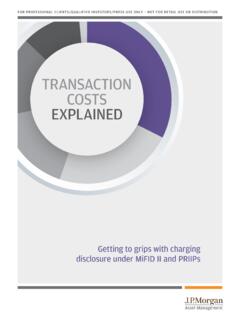
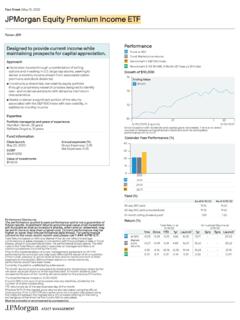
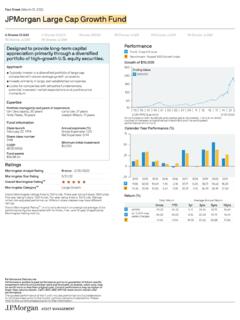
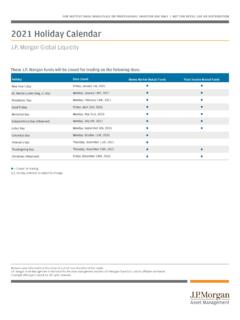
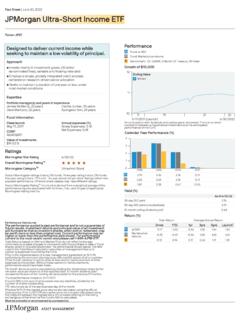
![MI-GTM 1Q17.pptx [Read-Only] - J.P. Morgan Asset …](/cache/preview/a/8/0/5/a/4/9/7/thumb-a805a4972c28a64389d8b5cdc3a7a25a.jpg)
